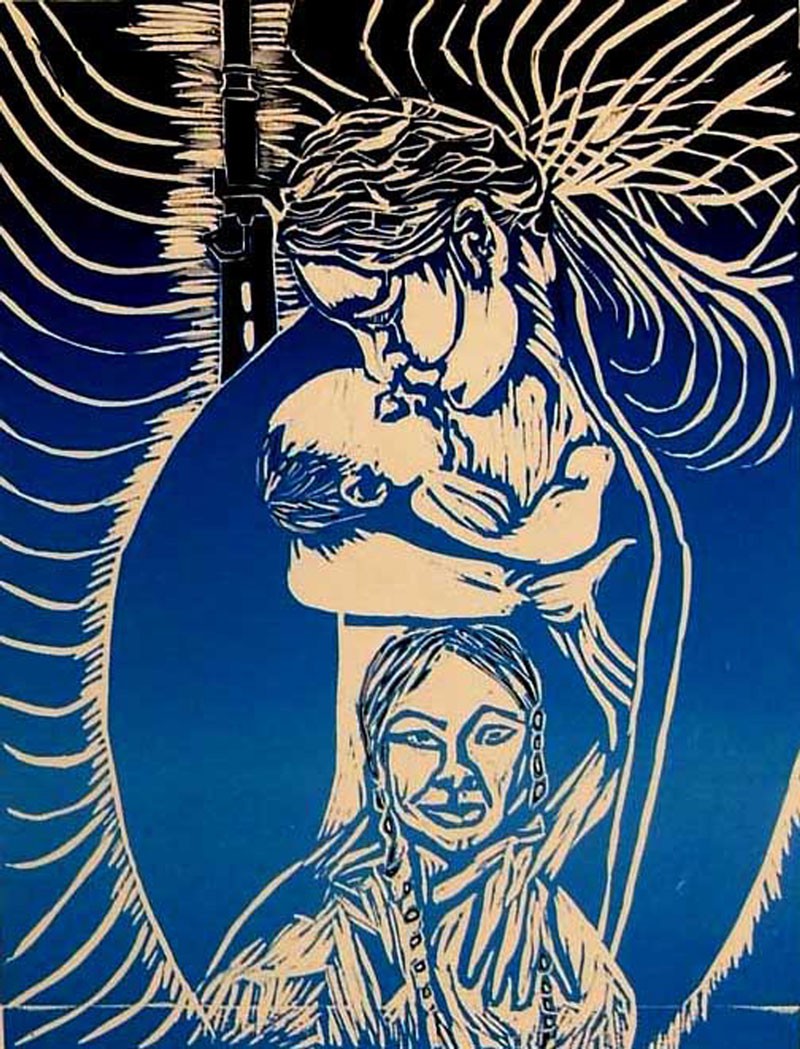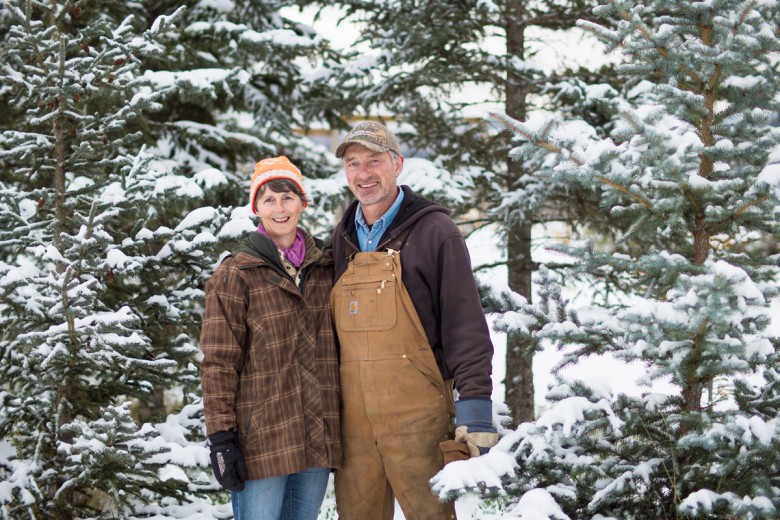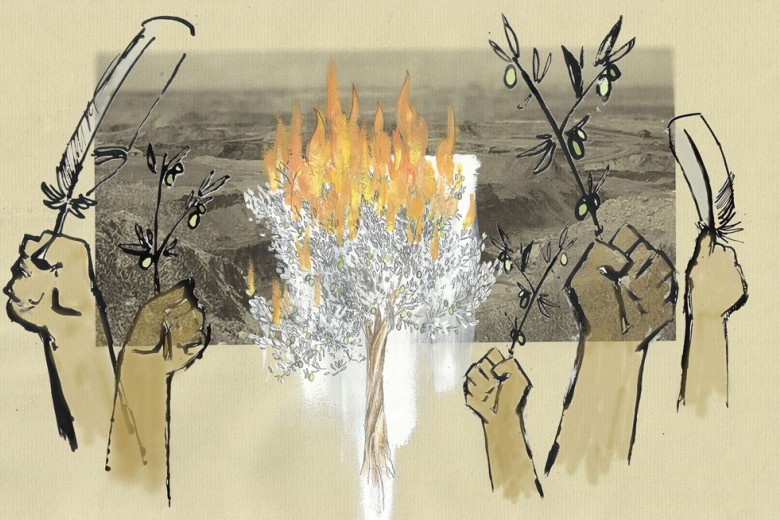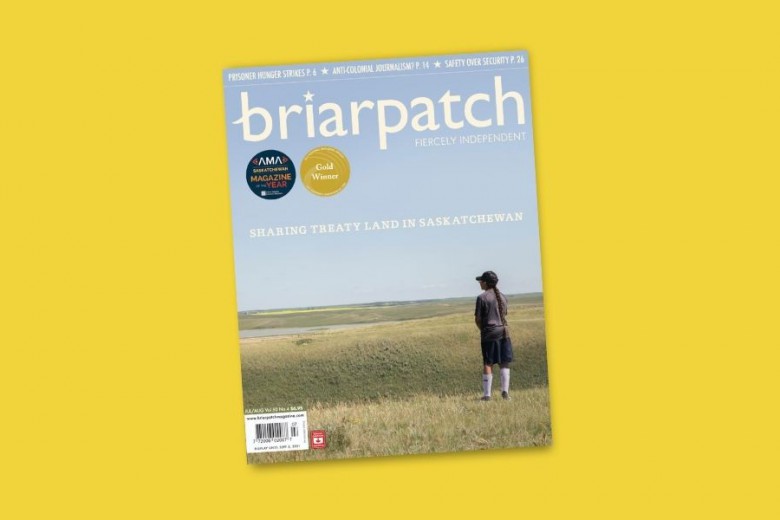
Nearly three years after Stephen Harper’s historic apology to residential school survivors, Canada’s iniquitous treatment of Indigenous children lives on. With over 27,000 First Nations children currently in foster care, there are more than three times as many Indigenous youth in state care than at the height of the residential school era in the 1940s.
“Reconciliation means not saying sorry twice” said Cindy Blackstock, executive director of First Nations Child and Family Caring Society of Canada, in a telephone interview with Briarpatch. “We are just asking that these kids be treated equitably, and Canada won’t.”
In 2007, Blackstock’s organization, along with the Assembly of First Nations (AFN), filed a Canadian Human Rights Commission (CHRC) complaint against the Canadian government for its discriminatory provision of child welfare services to First Nations children and families living on reserve.
According to evidence presented in the tribunal, while First Nations children in care are grossly overrepresented, they receive 22 per cent less child welfare funds than kids on the other side of the street.
First Nations children account for 30 to 40 per cent of all children in care, despite the fact that Aboriginal people make up only 4 per cent of the population in Canada. Yet Indian and Northern Affairs Canada (INAC) continues to provide no national funding to First Nations organizations for child and family services.
A grim situation on reserve
The dismal level of services on reserves in Canada is no secret. More than 3000 households on reserves are without running water, and nearly half of all homes require renovations due to mold or poor construction. Over a hundred boil-water alerts are currently in effect across First Nations communities, some dating back as far as 13 years. In this context, a lack of child welfare services in First Nations communities comes as no surprise.
“While we were looking after my nephew on reserve, we received no funds, no support and no attention from the government whatsoever” said Warner Naziel of the Wet’suwet’en Nation. “Yet when the boy was moved to a home off reserve, the money poured in” he said.
Naziel, a research consultant on the Moricetown reserve, had no previous first-hand experience with the child welfare system on reserve, and was stunned by the reality check he received after assuming care of his nephew.
“When we sought support, the ministry worker told me that since [my nephew] was kith and kin and now on reserve, I had to go to the social assistance worker at my local band office. I went there and all she said I would receive was about $200 for the month for him. Because of Antonio’s behavioral issues he needed professional psychological attention. The Ministry [of Child and Family Development] told me that I had to see our band office for assistance. We don’t have professional or trained trauma help on our reserve. We went without. Eventually, my sister took him in and had to fight tooth and nail with the ministry for any kind of help at all.”
The current federal funding regime on reserve focuses on “protection” — child apprehension, foster homes and institutional care, rather than prevention or family supports and in-home services for Aboriginal parents. This system encourages agencies to remove Aboriginal children from their parental homes instead of strengthening the support necessary to enable children to stay with their families in their cultural community.
“The absence of these services is a major reason why so many First Nation children are in care” states the official Assembly of First Nations website.
According to Preston Guno, a Nisga’a man and manager at Walk Tall, an Aboriginal youth organization in Prince George, B.C., “It appears that there is very little in the area of ‘child and family development’ and much more response in the area of bringing children in care when preventive supports could have averted this.”
Certainly, the facts clearly indicate that prevention services on reserve have not been prioritized by Canada. Approximately 5.8 per cent of First Nations children living on reserve are in care out of their parental homes, in comparison to the Canadian average of 0.8 per cent.
The legacy lives on
A clear pattern of racism surfaces with a quick look at Aboriginal child welfare on reserve in Canada. The situation reflects a paternalistic and colonial prototype of dealing with First Nations children as wards of the state, and bears striking similarities with Canada’s treatment of Aboriginal children in the Residential School System.
As residential schools were phased out (the last one closing down in 1996), the child welfare system became the new agent of assimilation and colonization. Beginning in the 1950s, swaths of Aboriginal children were taken from their families and handed over to white middle-class parents. This practice accelerated in what came to be known as the “Sixties Scoop” and was informed by a belief in the inherent superiority of the European way of life.
By the late 1970s, as many as one in three status Indian or Métis children (not including non-status Indians) were removed from their homes. In some provinces, one in two spent their childhood as a permanent ward of the government, many of whom were adopted into white homes. While the practice of mass apprehensions was discontinued in the mid-1980s, the transfer of Indigenous children from their homes and communities to state care continues in other forms.
Like residential school survivors, children growing up in foster care suffer cultural dislocation in addition to high rates of physical, emotional and sexual abuse. The multigenerational affects of this trauma, including poor parenting skills, have exacted a high toll on Aboriginal families.
Despite this, the Canadian Incidence Study of Reported Child Abuse and Neglect shows that First Nations children are put in care largely due to neglect driven by poverty, poor housing, substance misuse, and inequitable services — all of which could be addressed with improved services, but are not.
According to Preston Guno, the ethnocentric logic that traditionally guided the apprehension of Indigenous children continues to inform the foster care system in other ways as well.
“The primary role of extended family such as grandparents, aunts and uncles as primary caregivers has historically been how Aboriginal families lived, but this Eurocentric-driven system often views this approach as parents neglecting their roles and responsibilities as parents — therefore they will attract the attention of the child welfare system” Guno told Briarpatch.
Who is to blame?
In British Columbia, debate surrounding Aboriginal child protection has swelled following a number of recent controversies, including the death of a toddler in state care. Even the province has recognized the desperate state of child welfare services in First Nations communities, and requested a meeting last year with then-INAC minister Chuck Strahl to address the inequitable treatment of Aboriginal children in care on reserve.
In a letter to the B.C. ministers of Children and Family Development and of Aboriginal Relations and Reconciliation, Strahl declined their invitation, stating that he would “not be available to meet with you in the near future.”
The letter continued, “I appreciate and share your concerns for the equitable treatment of children on reserve to those living off reserve. While the British Columbia Enhanced Prevention Services Model and Accountability Framework will not be funded at this time, it is still under consideration for the next fiscal year.”
The letter also outlined a commitment to Jordan’s Principle, a model that aims to ensure that children receive the services they need, promptly and without jurisdictional disputes between federal and provincial or territorial governments.
The principle is based on the experience of Jordan River Anderson, a two-year-old boy of Norway House Cree Nation. Jordan spent over two years in hospital unnecessarily, as the Province of Manitoba and the Government of Canada could not agree on who should pay for his care when he was well enough to go home.
Tragically, at the age of 5, Jordan River Anderson passed away, never having spent a day in a family home, while governments continued to argue.
Jordan’s Principle calls on the government of first contact to pay for services for a child, with the option of referring the matter to jurisdictional dispute mechanisms thereafter.
While the federal government provides lip service to Jordan’s Principle, it has narrowed the interpretation of this code to apply only to children with complex medical needs who require multiple service providers.
“We find it out of step with Jordan’s Principle, and quite frankly a bit distasteful, [to] take the important memory of a child and reframe it is a narrow principle of equality” Cindy Blackstock commented at the 40th session of the Standing Committee on Aboriginal Affairs and Northern Development.
In January, an INAC representative told Briarpatch, “We are working towards an enhanced framework and implementing Jordan’s principle in all jurisdictions, and we are aiming for this to be complete by 2013.”
But according to Blackstock, the Auditor General of Canada has already found INAC’s “enhanced” approach to be flawed and inequitable. “They continue to shop it around as the exclusive option without having addressed its flaws” she said.
In response to the human rights complaint filed by Blackstock and the Assembly of First Nations, INAC has argued that if there is indeed disparity in the delivery of services, accountability rests with local child welfare agencies and not INAC.
“INAC’s argument has broad implications for First Nations service delivery as a whole as it chronically under-funds many services on reserves, such as policing and housing” said Blackstock. “If it is successful in saying it cannot be held accountable, as it is not a front-line service organization, then that basically offloads federal responsibility for discrimination to First Nations” Blackstock told Briarpatch.
Moving Forward
Unquestionably, a lot needs to happen in order for Aboriginal children to access fair treatment in Canada. Today, First Nations youth are the fastest-growing demographic in the country. And some of those youth see that changes to child welfare are still slow-moving.
Stuart Panko, an Anishinabe youth, spent most of his childhood in care. By age seven he had lived in 22 different foster homes before finding a First Nations foster family that accepted him as one of their own.
“No question, in my personal experience of growing up in the system, I would have been better off if I wasn’t put in foster homes where I was getting abused by my caregivers physically and emotionally” says Panko. “ If my mother had been given the supports she needed, my life may have been different” he said.
But Panko also sees that there is room for change. “The need for more positive male role models and keeping the connection to biological family, territory and culture is key” he says.
February 2011 marked the fourth anniversary since Blackstock and the AFN filed the complaint with the Human Rights Commission in 2007. Canada motioned to have the case dismissed in December 2007, but the tribunal has not yet issued its decision, despite a CHRC requirement that rulings on the merit of a given complaint be issued within a four-month period.
Since the First Nations Child and Family Caring Society of Canada and the AFN filed the human rights complaint in 2007, all of the Society’s federal funding has been cut.
But Canada’s leading First Nations child welfare advocate remains optimistic.
“With over 7000 people and organizations committed to following the tribunal, the case is one of the most formally watched legal actions in Canadian history, and has the potential to set a precedent of equity across all services on reserves” Blackstock said.
“For First Nations children, a ruling that Canada must rectify the discrimination would offer up more opportunity to stay safely with their families and communities, and to experience equitable government funding in areas like education and health, which are also underfunded on reserves. For Canadians, it would be a time to finally turn the page on the longstanding harmful treatment of First Nations children.”






